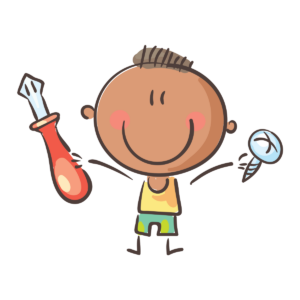The Greater Cincinnati STEM Collaborative has developed unique resources
Family engagement is at the core of all the work of the Greater Cincinnati STEM Collaborative.
Mary Adams, executive director of the ecosystem, says she and other ecosystem leaders have long recognized that “if you’re not changing the conversation at the dinner table, you’re not going to get there.”

“We’ve always recognized that families have arguably the most important role in this work,” she says.
In Cincinnati, the strategy is to provide resources to parents and educators instead of running family engagement programming.
Lately, with the help of Emilee Armbruster, who started with the ecosystem as an AmeriCorps VISTA and is now Program Coordinator, family engagement strategies have gained even greater momentum.
Social media
Armbruster has made Greater Cincinnati ecosystem’s communications work more compelling, including ramping up its social media presence and analyzing the relationship between GCSC and its audiences.
 For instance, recent social media posts have focused both on what GCSC does in the community as well as the other resources partners have created around STEM. The communication has focused on how resources are beneficial for families and their network.
For instance, recent social media posts have focused both on what GCSC does in the community as well as the other resources partners have created around STEM. The communication has focused on how resources are beneficial for families and their network.
Armbruster explains the thinking about the communications strategy, “It’s important to understand why people are paying attention to what you are saying. Then you build on that so they stay engaged. For example, how can we explain what STEM is and STEM careers so that families turn to us for information on STEM opportunities in our area.”
In addition to the online communications strategy, the Greater Cincinnati STEM Collaborative has an aggressive outreach plan, involving tools and resources and appearances at various STEM-related events and community gatherings.
Adams explains that some families don’t know what STEM is and need information to better understand the benefits to seize STEM education and skill development opportunities for their children.
Helping families communicate with their children
In 2014, the ecosystem created a STEM Companion Guide to help families talk to their children about STEM and understand why that conversation is worthy. Complete with real stories about students and their STEM experiences, ecosystem leaders often distribute the guide at various events. Access the online guide here.
“We recognize a lot of parents maybe haven’t heard about STEM yet. They may be intimidated by STEM or they might have some misunderstandings of who can pursue it,” Adams says.
The companion includes a section devoted to breaking down barriers and busting myths, including how to work with students who say they’re not good with math.
Career Pathways
STEM career opportunities are featured in the guide and it is downloadable in both English and Spanish.
Additionally, the ecosystem has also created a flier to give to parents, illustrating the STEM pipeline.
“In Greater Cincinnati, we have more STEM job vacancies than we do qualified candidates to fill them and we need families to understand STEM pathways,” Armbruster says. The flier includes facts that explain that getting involved in math or science clubs makes children more likely to pursue a STEM major in college.
The flier outlines a possible pathway to follow for various STEM careers.
STEM at home
Ecosystem leaders quickly realized that families also needed tools and simple ideas to use in their homes for engaging students. “Some parents would think, ‘oh, I need all of these special tools to do STEM at home,’ and we knew that wasn’t true,” Armbruster says. This discovery prompted the ecosystem to develop a set of 52 STEM activity playing cards for families to use. See the card deck here.
 Armbruster has been the chief designer and developer of this family engagement resource that the ecosystem began distributing in Summer 2019.
Armbruster has been the chief designer and developer of this family engagement resource that the ecosystem began distributing in Summer 2019.
The 52 cards are broken into four sections – science, technology, engineering, and math. Each card has a different STEM activity on it, geared for various grade levels.
Armbruster says the activities were designed to make use of materials that most families likely have in their homes. For instance, an engineering activity involves plastic cups and string to make a wrecking ball to knock down the cups.
A few coding activities in the technology section involve Simon Says types of steps.
“These activities help families learn and play together and take away some of the intimidation they may have had with STEM,” says Armbruster.
Greater Cincinnati STEM Collaborative
GCSC is a nonprofit on the mission to create a robust STEM (Science, Technology, Engineering and Mathematics) pipeline of talent. This talent pipeline will meet the accelerating demand for STEM jobs in our region. GCSC brings education, community and business partners together to create hands-on, real life, and relevant learning experiences for our students. These authentic experiences are proven to grow student interest in and confidence to pursue STEM careers.
As a collaborative, we have numerous members including formal educators from schools in Cincinnati and Northern Kentucky, informal educators from local museums and science programs, and interested business partners. These members are the energy behind making our Greater Cincinnati region a leader in STEM education.
Regional experts in business, education and philanthropy advise the GCSC.
The GCSC uses a Collaborative Circle organizational model. This is a small, flat organization that focuses on getting the work done and remaining agile to seize opportunities as they present themselves. Depending on the GCSC strategies and priority projects, members flex as needed to support the work.
